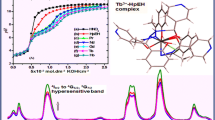Summary
The thermodynamic proton-ligand and metal ligand stability constants of the newN-o-chlorophenylbenzohydroxamic acids with manganese, nickel, copper, zinc, cadmium and mercury have been determined in 1 : 1 dioxan : water at 25°.
The stability of the complexes mostly follow the ligand basicity order and also the metal ion electron affinities as measured by their ionization potential. The stability constants of the metal complexes follow the order: Cu(II) > Zn(II) > Ni(II) > Mn(II) > Hg(II) > Cd(II).
Similar content being viewed by others
References
Y. K. Agrawal,Russ. Chem. Rev., 48, 948 (1979).
Y. K. Agrawal,Studies on Hydroxamic Acids, D.Sc. Thesis, A.P.S. Univ., Rewa, 1980.
Y. K. Agrawal and S. G. Tandon,J. Inorg. Nucl. Chem., 34, 1241 (1972):36, 869 (1974).
Y. K. Agrawal, S. K. Sant and T.R. Jagdeesh,Convention of Chemists, Madurai, 74 Phy. II 68, p. 106, 1974.
Y. K. Agrawal and B. N. Rathi,J. Chem. Eng. Data, in press.
A. Weissberger, E. S. Proskaure, J. A. Riddick and J. R. Toops,Technique of Organic Chemistry, Interscience, New York, 1955, Vol. 1.
I. M. Kolthoff and E. B. Sandell,A Textbook of Quantitative Inorganic Analysis, Macmillan, London, 1952, p. 517, 527.
A. I. Vogel,A Textbook of Practical Organic Chemistry, Longmans, London, 1956.
H. M. Irving and H. S. Rossotti,J. Chem. Soc., 2910 (1954).
H. M. Irving and U. S. Mahnot,J. Inorg. Nucl. Chem., 30, 1215 (1968).
Y. K. Agrawal and S. G. Tandon,Talanta, 19, 700 (1972).
Y. K. Agrawal and S. G. Tandon,J. Electroanal. Chem., 40, 158 (1973).
Y. K. Agrawal and H. L. Kapoor,J. Chem. Eng. Data, 22, 159 (1977).
L. P. Hammett,Chem. Rev., 17, 123 (1935).
H. H. Jaffee,Chem. Rev., 53, 191 (1953).
Y. K. Agrawal,Ann. Chem., 2, 5 (1977).
Y. K. Agrawal and J. P. Shukla,Aust. J. Chem., 26, 913 (1973).
Y. K. Agrawal and R. D. Roshania,Bull. Soc. Chim. Belg., in press.
Y. K. Agrawal,Bull. Soc. Chim. Belg., 86, 565 (1977).
G. Schwarxenbach, G. Ackermann and P. Ruekstahl,Helv. Chim. Acta, 32, 1175 (1949).
Y. K. Agrawal and A. Mudaliar,Transition Met. Chem., 4 252 (1979).
L. E. Maley and D. P. Mellor,Aust. J. Sci. Res., 42, 579 (1949);Nature, 159, 370 (1947).
H. Irving and R. J. P. Williams,J. Chem. Soc., 3192 (1953).
H. Irving and R. J. P. Williams,Nature, 162, 746 (1948).
L. E. Orgel,An Introduction to Transition-Metal Chemistry: Ligand Field Theory, Methuen, London, 1966.
M. B. Kabadi and K. S. Math,Proc. Symp. Chem. Coordination Compounds, Agra, Part III, p. 65, 1959.
L. G. Van Uitert, W. C. Fernelius and B. E. Douglas,J. Am. Chem. Soc., 75, 2736 (1953).
W. D. Johnston and H. Freiser,Anal. Chim. Acta, 11, 201 (1954); (a)ibid, 11, 301 (1954).
L. L. Quill,The Chemistry of Materials Thermodynamics, National Nuclear Energy Series, Div.. IV, Vol. 19 B.
J. Bjerrum,Metal Aminine Formation in Aqueous Solution, P. Hasse, Copenhagen, 1941.
Stability Constants of Metal Ion Complexes. Part-I, Chem. Soc. London, Special Publication, 1957, p. 2–13.
Author information
Authors and Affiliations
Rights and permissions
About this article
Cite this article
Agrawal, Y.K., Rathi, B.N. Proton-ligand and metal ligand stability constants ofN-o-chlorophenylbenzohydroxamic acids with manganese(II), nickel(II), copper(II), zinc(II), cadmium(II) and mercury(II). Transition Met Chem 11, 472–475 (1986). https://doi.org/10.1007/BF01386880
Received:
Issue Date:
DOI: https://doi.org/10.1007/BF01386880




